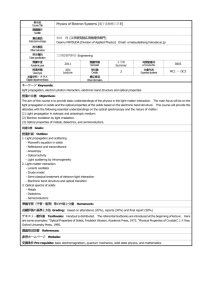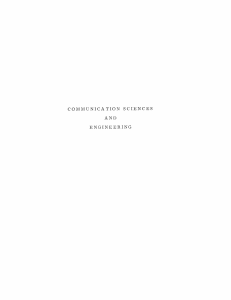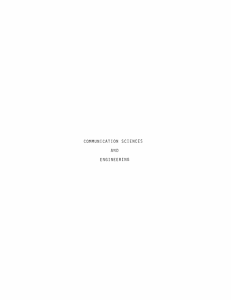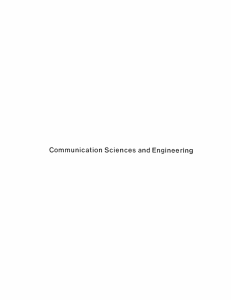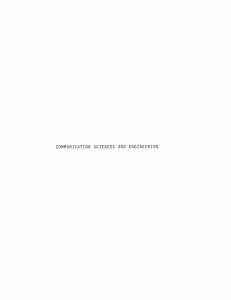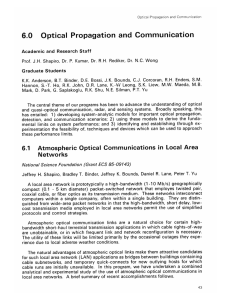COMMUNICATION SCIENCES AND ENGINEERING
advertisement
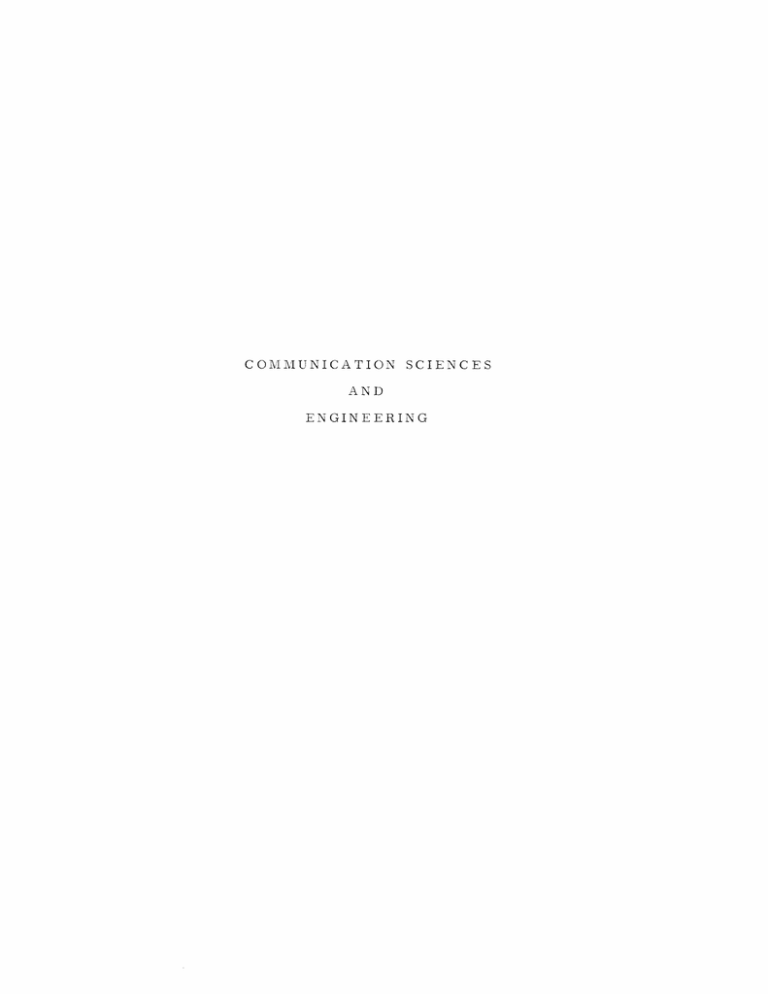
COMMUNICATION SCIENCES AND ENGINEERING XX. OPTICAL PROPAGATION AND COMMUNICATION Academic and Research Staff Prof. Robert S. Kennedy Prof. Jeffrey H. Shapiro Prof. Cardinal Warde Dr. Vincent Chan Dr. Horace P. H. Yuen Graduate Students M. Yousoof Burmawi Marcel F. Coderch Paul J. Curlander Jesus A. Machado-Mata Nam-Soo Myung Woo Hyun Paik Warren S. Ross Diane C. Simmons Steven V. Sperry Mahmoud Tebyani The broad objectives of our program are to (i) formulate propagation models for important optical channels from the underlying physical processes, (ii) determine the fundamental limits on detection and communication performance that can be realized with these channels, (iii) develop techniques for optical detection and communication which achieve or approach these limits, and (iv) establish, by means of experiment, the validity of the theoretical results and guide their further development. 1. QUANTUM COMMUNICATION THEORY National Aeronautics and Space Administration (Grant NGL 22-009-013) U. S. Navy - Office of Naval Research (Contract N00014-76-C-0605) Joint Services Electronics Program (Contract DAABO7-76-C- 1400) Horace P. H. Yuen, Jeffrey H. Shapiro, Robert S. Kennedy The long-range goal of this investigation is to realize improved optical communication, detection, and estimation in the space environment. Such improvement may be possible through the use of quantum measurements (optical receivers) that are superior to those now considered and the use of quantum states other than coherent states.1 Our major goal during the next year is to design an experiment which will demonstrate that the desired quantum states, which are called two-photon coherent states, can be produced. References 1. R. S. Kennedy, "Problems in Quantum Communication and Information Theory," presented at the 1975 IEEE-USSR Joint Workshop on Information Theory, Moscow, 1975 (Proceedings published by IEEE, 75CH1167-61T), pp. 105-110. PR No. 120 (XX. 2. OPTICAL PROPAGATION AND COMMUNICATION) IMPROVED LOW-VISIBILITY COMMUNICATION National Science Foundation (Grant ENG74-00131-A03) U. S. Air Force - Electronic Systems Division (Contract F19628-76-C-0054) Robert S. Kennedy, Jeffrey H. Shapiro, Cardinal Warde This investigation, which is carried out jointly with the M. I. T. Center for Materials Science and Engineering, is concerned with the performance of terrestrial line-of-sight communication systems under conditions of low visibility. Our aim is to determine the extent to which performance can be improved through appropriate system design, and to develop the devices for achieving this improvement. The potential for improvement resides in the energy and information contained in the scattered component of the received field. The collection of data to establish the frequency, variability, and the regularity of the key channel parameters has been a major concern during the past year. Measurements taken on a 13-km line-of-sight path at 0. 69 1im and 2 lm wavelengths have shown little dispersion of the field, either in time or angle, for optical thicknesses as large as ten. Up to that optical thickness, the results are well approximated by the predicted unscattered field.1 Recently we have installed new 1.06 4m and 0.54 Lm lasers with which we expect to be able to operate at lower visibilities. References 1. W. H. Paik, M. Tebyani, D. J. Epstein, R. S. Kennedy, and J. H. Shapiro, "Propagation Experiments in Low-Visibility Atmospheres" (to appear in Applied Optics). 3. OPTICAL PROPAGATION AND COMMUNICATION THROUGH ATMOSPHERIC TURBULENCE National Science Foundation (Grant ENG74-03996-A01) Jeffrey H. Shapiro sought to quantify the performance limitations imposed by atmospheric turbulence on specific imaging and optical communication systems, and to develop system configurations that are immune to atmospheric fluctuations. Our work in previous years has established a rigorous analytical framework In this investigation, we have for parametric performance comparisons among various imaging and communication system alternatives.1 During the past year, we have focused our attention on channel/ signal estimation structures and their performance. In particular, we have examined the design and performance of focal-plane detection arrays using a state-variable PR No. 120 100 (XX. OPTICAL PROPAGATION AND COMMUNICATION) atmospheric propagation model that includes both drift and evolution terms in its temporal behavior. These results, which will appear in Marcel F. Coderch's S.M. thesis, 2 comprise the final work done under this program. References 1. J. H. Shapiro, "Imaging and Optical Communication through Atmospheric Turbulence" (to appear in J. W. Strohbehn (Ed.), Laser Beam Propagation through the Atmosphere, Springer Verlag, Berlin). 2. M. F. Coderch, "Focal Plane Optical Detection for Turbulent Channels," S.M. thesis proposal, Department of Electrical Engineering and Computer Science, M.I. T., May 1977. PR No. 120 101
